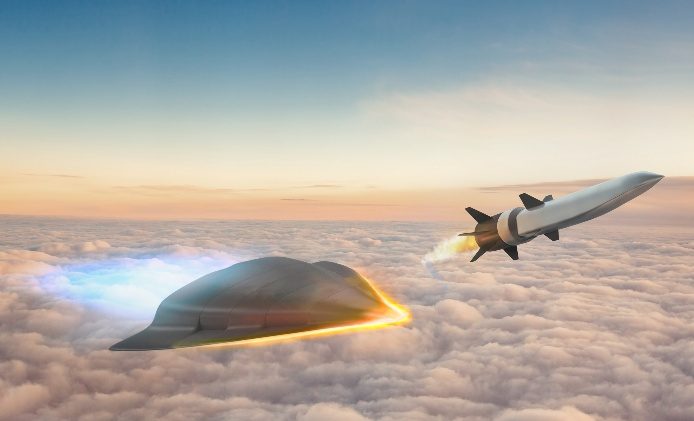
Hypersonic Weapons: New ‘Sprint Kings’ In Strategic Weapons Race

Image Source: Raytheon Technologies
It was reported on 16/17 October in several periodicals/dailies that China had tested a Hypersonic Glide Vehicle (HGV) in August this year (this was promptly refuted by the Chinese Foreign Ministry on 18 Oct, who stated that a ‘space vehicle’ was tested, and not a ‘nuclear capable hypersonic missile’). As per reports, the nuclear capable HGV followed a Low-Earth Orbit (LEO) before descending towards its target, which it missed by a margin of over 30 km. The HGV was mounted on a Long March Rocket which put the former into LEO. China’s diligent pursuance of hypersonic technology includes the development of the DF-ZF HGV (believed to be able to fly at speeds of between Mach 5 and Mach 10 with extreme manoeuverability in order to evade existing BMD systems), earlier covered in an article @ Chanakya Forum https://chanakyaforum.com/chinas-nuclear-forces-dragon-fire-or-facade/ .
On 19 July this year, Russia launched a 3M22 ‘Zircon’ Anti-Ship Hypersonic Cruise Missile (HCM) with a reported top speed of Mach 9 and a range of 1000 km from an Admiral Gorshkov Class frigate in the White Sea, which successfully intercepted its target in the Barents Sea, 350 km away, at an interception speed of Mach 7.
Most recently, Russia also successfully test-fired the Zircon from a Yasen Class nuclear powered submarine, the Severodvinsk, in the Barents Sea on 04 October this year. Russia has thus successfully added the Zircon to its existing arsenal of hypersonic weapons, which includes the Avangard HGV, with a claimed range of over 6000 km and a top speed of Mach 27, that can be carried as a MIRV payload aboard existing Russian ICBMs and the Kinzhal air launched, nuclear capable HCM, with a claimed range in excess of 2000 km and a top speed of Mach 10. The Avangard entered service with the Russian Armed Forces in December 2019, while live-tests of the Kinzhal are still ongoing.
Hypersonic weapons development and testing have been in the limelight in the recent months, with a number of countries showcasing their missiles being fired in presence of their national leaders. The public announcement of successful tests often witnessed by the top political leadership of nations underscores the huge role these missiles are poised to play in foreign policy and warfare in the years to come. The traditional notions of deterrence will have to be rethought as the impact of hypersonic weapons on geopolitics is closer than what has been anticipated after the spate of test firings have come into public domain.
Most major powers, including Russia, China and the US have been racing to develop hypersonic missile – a missile system so fast that it cannot be intercepted by any current missile defence system. The weapon is a technological marvel, but is a cause of concern as many so-called rogue nations like North Korea have also declared possession of hypersonic missile technology.
While even ballistic missiles in their terminal phase regularly reach hypersonic speeds, it is evident from the above that development hypersonic cruise/glide technology is the present focus amongst a plethora of Nations-an advancement that was bound to follow the development and deployment of the seemingly impenetrable ‘shield’ offered by Ballistic Missile Defence (BMD) Systems in service with various countries. Presently, US, Russia, China, UK, France, India and Brazil are some of the countries pursuing the HCM/ HGV technology, either individually or in collaboration.
What is a Hypersonic Cruise Missile (HCM) / Hypersonic Glide Vehicle (HGV)?
A hypersonic weapon is one that can travel at speeds in excess of Mach 5 (6125 kmph).
HCMs are propelled towards their target with the help of a scramjet propulsion system. The scramjet is, in effect, a supersonic combustion ramjet engine, which allows combustion of fuel to take place with supersonic air flow, without slowing this airflow to subsonic levels as in a ramjet. The trajectory of the HCM is non-ballistic i.e. it can be varied, unlike the predictable trajectory of ballistic missiles which travel under the influence of the Earth’s gravity in their ballistic phase to reach their target.
On the other hand, HGVs are typically mounted on launch vehicles to carry them into sub-orbital trajectory past re-entry altitude. The HGV warheads are then released and re-enter the Earth’s atmosphere at hypersonic speeds. Unlike ballistic missiles, where payload flight towards the target is governed solely by gravitational force, the HGV rides on atmospheric shock waves generated by its hypersonic flight towards the target. The HGV thus ‘surfs’ the atmosphere at altitudes between 40 to 100 km, with the help of flight control surfaces, while gliding towards its target.
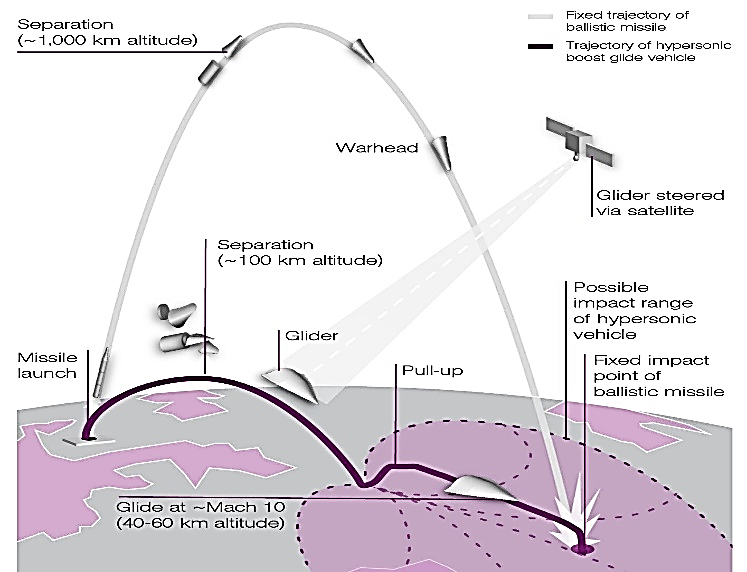
A Comparison of Ballistic Missile and HGV Trajectories: Source- southfront.org
Another category of hypersonic weapons are the Guided Ballistic Missiles, such as China’s DF-26, which perform like normal ballistic missiles during the powered and re-entry phase, post which they can be guided onto the target with the help of control surfaces or steering fins. Since these weapons function as ballistic missiles for the majority of their flight and would possess the same vulnerabilities to interception (albeit marginally better) as ballistic missiles, the author broadbands these weapons under the ballistic missile category and these are therefore not dealt with further in this article.
Hypersonic weapons generally adopt the Winged Hound or conical (blended body) design, which, due to their aerodynamic shape, provide high lift-to-drag ratio and allow for greater manoeuverability. Trajectory alteration may be done with the help of control surfaces such as canards or fins or with the help of thrust vector control using a reaction control system (RCS).
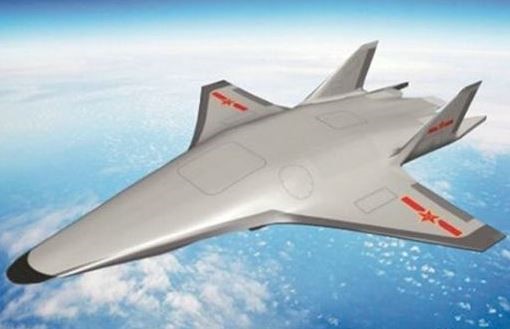
Chinese DF-ZF Concept Photo Showing Typical Winged Hound Design: Source- china-arms.com

US Concept Advanced Hypersonic Weapon (AHW) Showing Conical Design: Source- defencemedianetwork.com
The HCM/ HGV typically use Global Positioning System (GPS), Inertial Navigation and Synthetic Aperture radar (SAR) for guidance and navigation.
Global Development
While a handful of Nations as mentioned above are developing hypersonic weapons technology, US, Russia and China have emerged as the frontrunners in this field. The technological developments by these countries are encapsulated in succeeding paragraphs.
USA. The US has actively pursued the development of hypersonic weapons as part of its Conventional Prompt Global Strike (CPGS) program since the early 2000s. As per a US Congressional Research Service report, the US is working on at least eight distinct hypersonic weapon programs. However, unlike Russia and China, the US is yet to operationally field a hypersonic weapon and is unlikely to field one before 2023. As per the report, the US budget outlay for hypersonic weapons R&D in FY 2022 is a staggering US $ 3.8 Billion, an increase from US $ 3.2 Billion allocated in the last FY! The development programs include the Air Launched Rapid Response Weapon (ARRW), Hypersonic Conventional Strike Weapon (HCSW) and Hypersonic Air- Breathing Weapon Concept (HAWC)- all for the US Air Force; Common Hypersonic Glide Body (CHGB), a joint Army- Navy program; an Intermediate Conventional Prompt Strike Weapon (CPS) for the US Navy; a Long Range Hypersonic Weapon (LRHW) for the US Army and an Operational Fires program for the Defense Advanced Research Projects Agency (DARPA). The US has in recent years, focussed on development of HGVs, which in the words of Vice Chairman of the Joint Chiefs of Staff and former Commander of U.S. Strategic Command General John Hyten, would enable “responsive, long-range, strike options against distant, defended, and/or time-critical threats when other forces are unavailable, denied access, or not preferred.” It would be interesting to note that most U.S. hypersonic weapons programs, in contrast to those in Russia and China, are not being designed for use with a nuclear warhead. This would imply that developments in the field of hypersonic weapons by the US would look at technologies that would give greater accuracy- a challenging technological feat. The roadmap envisages development, testing and platform deployment upto 2028 for various programs.
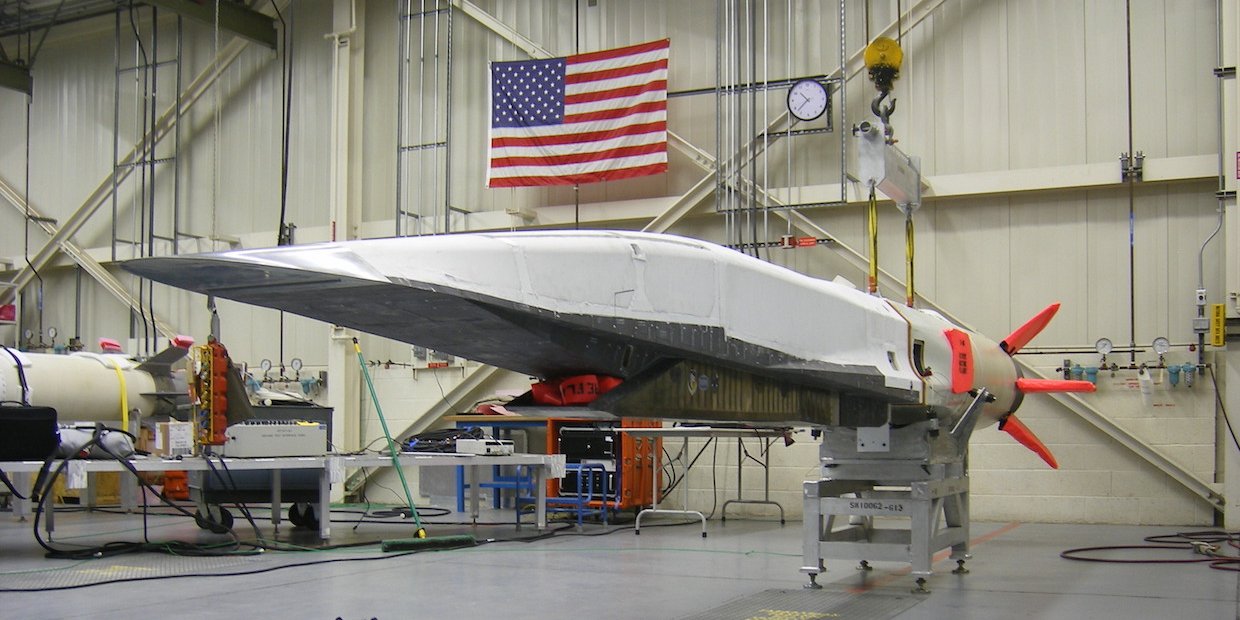
Russia. Although Russia has conducted research on hypersonic weapons technology since the 1980s, it accelerated its efforts in response to U.S. BMD deployments and the U.S. withdrawal from the Anti-Ballistic Missile Treaty in 2001. Russia is therefore likely to be looking at development of hypersonic weapons with manoeuverable trajectories that can penetrate US BMD shields. Russia is currently pursuing the Avangard, the 3M22 Zircon (Tsirkon) and Kinzhal hypersonic weapons programs. Reports indicate that Avangard is currently deployed on the SS-19 Stiletto ICBM, with plans to launch the HGV from the Sarmat ICBM, scheduled for deployment by the end of next year. Avangard will reportedly carry a nuclear warhead. As elucidated above, the Avangard is operationally deployed and can be fired from surface ships and submarines using vertical launch systems. The Zircon HCM is likely to enter operational service in 2023. The Kinzhal Air Launched HCM is based on the Iskander Ballistic Missile. Russia plans to deploy the Kinzhal on the MiG-31 and SU-34 fighter aircraft as well as the Tu-22M3 strategic bomber. The HCM would be capable of striking ground as well as maritime targets.
China. China is believed to possess robust hypersonic weapon R&D infrastructure and is credited with conducting a far greater number of hypersonic weapon tests than the US. Hypersonic technology is not new to China- a hypersonic unmanned aerial vehicle (UAV) was reportedly tested in 2015, presumably as a future intelligence, surveillance and reconnaissance (ISR) platform. While development of hypersonic weapons were a late arrival in China’s missile development programs, these assets are now being developed aggressively, characterized by a large investment in test facilities and frequent testing. The drivers for China’s hypersonic weapons programs are similar to that of Russia’s- the concern that US could use hypersonic weapons to conduct a pre-emptive, crippling strike on China’s nuclear arsenal and supporting infrastructure, while preventing a retaliatory strike on US territory owing to the latter’s BMD shields. China follows Russia’s hypersonic weapons development closely, which is evinced by the frequent references to Russia’s program in Chinese papers outlining their own hypersonic weapons development. China has conducted a number of successful tests of the DF-17, a road-mobile medium-range ballistic missile specifically designed to launch the DF-ZF HGV (as referred to previously in this article). China also successfully tested Starry Sky-2 (or Xing Kong-2), a nuclear-capable hypersonic vehicle prototype, with a range of 800 km, which China claims has reached top speeds of Mach 6 and successfully executed a series of in-flight manoeuvres before landing. China presently seems to be concentrating its development on conventionally-armed hypersonic vehicles for regional employment. However, China’s thoughts towards mating HGVs with DF-41 ICBM or the DF-21/DF-26 Intermediate Range Ballistic Missiles, could pose a future threat to US mainland and offshore facilities and would complement China’s Anti-Access Area Denial (A2AD) strategy. Nuclear tipped HGVs aboard these vectors are also likely to be aimed towards enhancing strategic deterrence against the US, a move that mirrors similar actions by Russia, as stated above.
North Korea. North Korea test-fired a newly developed hypersonic missile in September 2021 as reported by state news media KCNA, joining the race headed by major military powers. However South Korean reports said the North’s hypersonic missile was at an early stage of development, judging by detected velocity and other data, and would take a “considerable period of time” until it could be deployed. The missile, called the Hwasong-8, performed to its technical targets “including the guiding manoeuvrability and the gliding flight characteristics of the detached hypersonic gliding warhead”, claimed North Korea. But in all likelihood, the North’s test of the HGV was a failure, given the flight was clocked at Mach 2.5 as assessed by South Korean military intelligence. The technology is not at par with US, China or Russia, but for now seems to aim for short-range that can target South Korea or Japan.
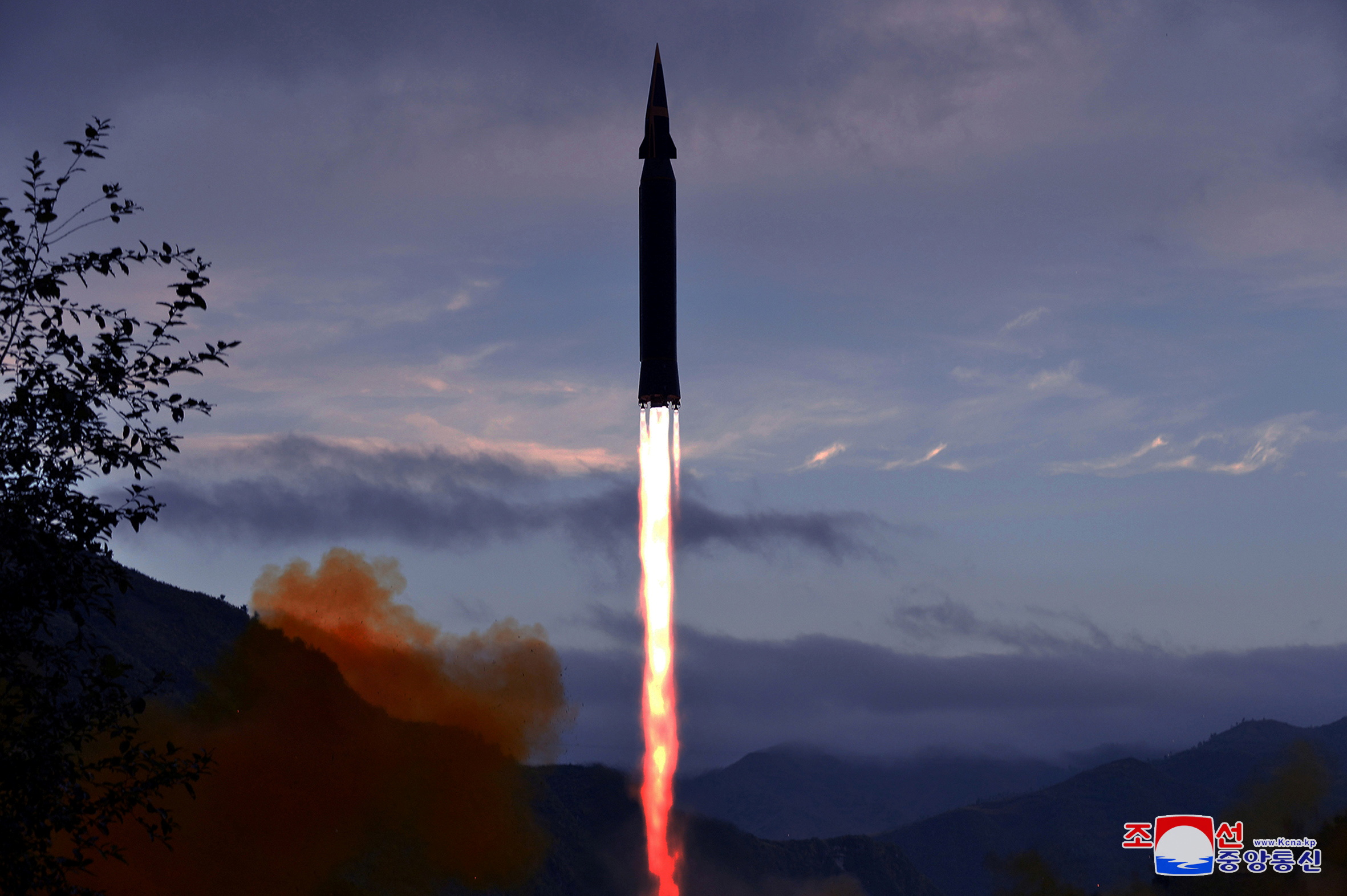
Source: KCNA via Reuters
India’s Hypersonic Weapons Roadmap
On 07 September 2020, India conducted its first successful test launch (and second overall) of the Hypersonic Technology Demonstrator Vehicle (HSTDV) from the Dr APJ Abdul Kalam (Wheeler) Island in the Bay of Bengal. The HSDTV is designed to carry a 150 kg payload at Mach 12 or 14,300 kmph, significantly faster than China’s DF-ZF HGV! Launch of the HSDTV was carried out using the Agni Missile solid fuel rocket booster, which launched the hypersonic vehicle to an altitude of 30 km. The cruise vehicle, post separation from the launch vehicle, sustained flight along the planned flight path at Mach 6 for 20 seconds, with the help of its scramjet engine. This launch demonstrated to the world India’s capability to indigenously produce hypersonic vehicles.
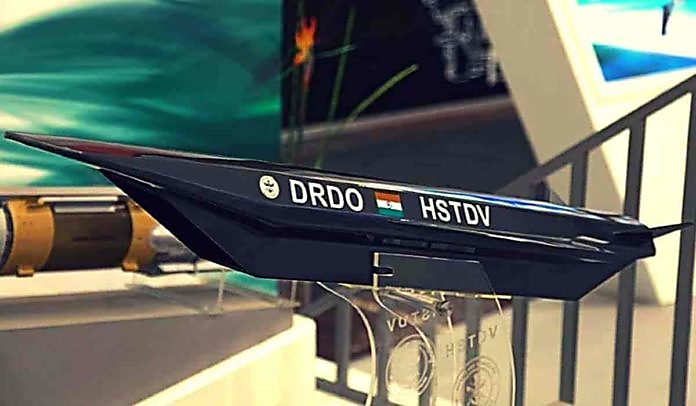
HSDTV: Source-DRDO
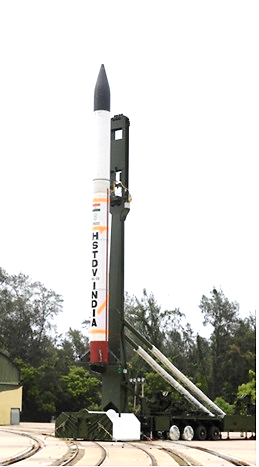
HSDTV Mounted on Agni Missile Booster before Launch on 07 September 2020: Source-wikepedia.org
BrahMos- II. The BrahMos-II is a HCM under development that is estimated to have a range of 600 km and speed upto Mach 8 (9,800 kmph). The variant is under development and is likely to be fielded by the end of the decade. The same has been covered in detail in a previous article @ Chanakya Forum https://chanakyaforum.com/brahmos-cruise-missile-indias-contender-in-the-supersonic-vector-race/ .

BrahMos-II: Source-wikepedia.org
Conclusion
Hypersonic weapons will require a paradigm shift in military thinking, necessitated by their seemingly ‘invincible’ nature, in turn borne by the fact that the present BMD systems the world over are largely incapable of defence against these new generation weapons. In the absence of any global regulatory protocols over hypersonic weapons, countries with existing or developing capability in the field need to guard against the inevitable urge to use such weapons in the unfortunate circumstance of conflict, where predictability and reaction times are reduced to near negligible levels and Nuclear Weapon States are coerced into altering nuclear weapon usage policies, lest the same be lost to hypersonic weapon attacks. Global consideration of terms of use are therefore imperative to streamline employment concepts and elucidate boundaries of use of these new global ‘sprint’ kings in the manoeuverable strategic weapons race!
Disclaimer
The opinions expressed in this article are the author’s own and do not reflect the views of Chanakya Forum. All information provided in this article including timeliness, completeness, accuracy, suitability or validity of information referenced therein, is the sole responsibility of the author. www.chanakyaforum.com does not assume any responsibility for the same.
Chanakya Forum is now on . Click here to join our channel (@ChanakyaForum) and stay updated with the latest headlines and articles.
Important
We work round the clock to bring you the finest articles and updates from around the world. There is a team that works tirelessly to ensure that you have a seamless reading experience. But all this costs money. Please support us so that we keep doing what we do best. Happy Reading
Support Us





















POST COMMENTS (1)
North Korea’s Missiles: Road To Advancement Or Armageddon? - Chanakya Forum